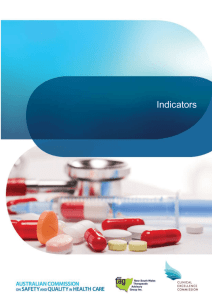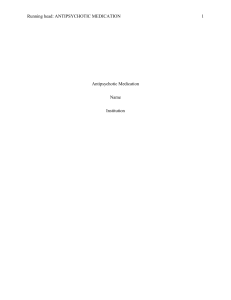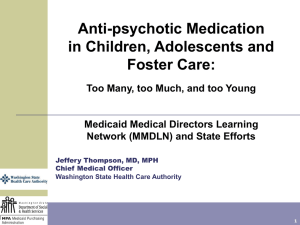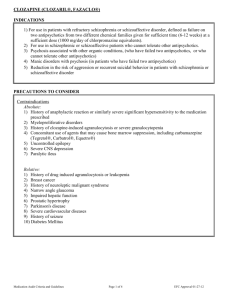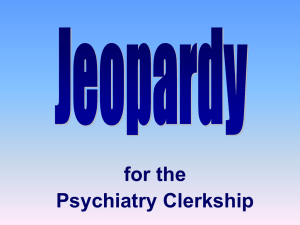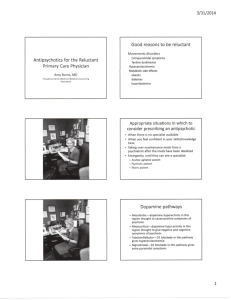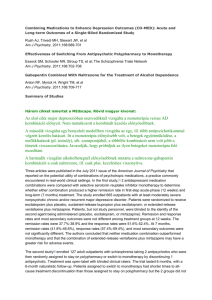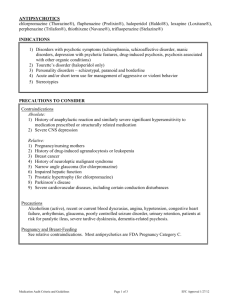WORD - Australian Commission on Safety and Quality in Health Care
advertisement
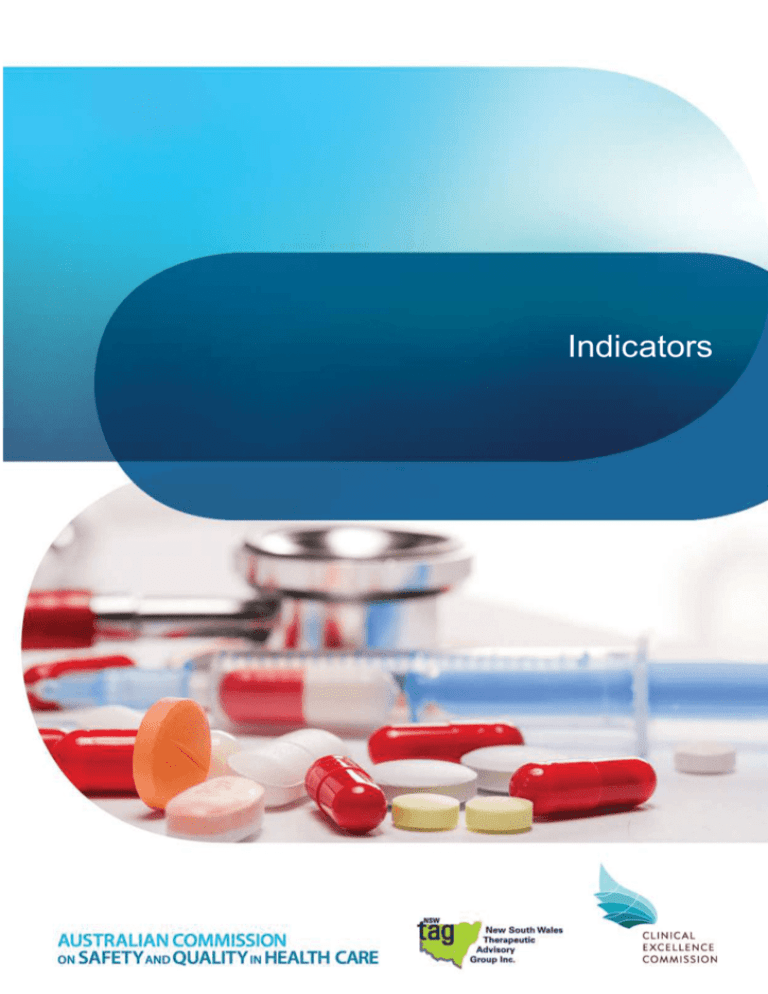
Indicators Acute mental health care QUM domains: Judicious selection Safe and effective use 7.5 Percentage of patients prescribed two or more regular antipsychotic medicines at hospital discharge Purpose This indicator addresses the effectiveness of processes for ensuring that mental health patients are managed in accordance with evidence-based guidelines. Background and evidence Antipsychotics are the cornerstone of the management of schizophrenia and related psychoses. They are used to treat the acute symptoms and reduce the risk of subsequent relapse. Guidelines recommend the use of only one antipsychotic medicine at a time. 1-3 Even in patients with a history of treatment resistance there is limited data to support the use of more than one antipsychotic at a time (polypharmacy). 2,4-6 In the longer term, antipsychotic polypharmacy has been associated with increased morbidity and mortality. 3 Polypharmacy increases the risk of adverse effects, increases costs and complicates medication regimens, all of which potentially reduce patient adherence to therapy. Key definitions Patients includes all patients (whether they are taking antipsychotics or not) discharged from an inpatient mental health bed to home or residential care. Regular antipsychotic medicines refers to any antipsychotic medicine 3, including typical and atypical antipsychotics, intended to be taken on a regular basis. These may be administered by any route, including oral or parenteral. Medicines to be taken on an as required basis should not be included. The antipsychotic medicine should only be counted once, if more than one formulation of the same medicine is prescribed. At hospital discharge means that the intention was to continue the prescribed antipsychotics after discharge. Data collection for local use Please refer to the section Using the National Quality Use of Medicines Indicators for Australian Hospitals for guidance on sample selection, sample size, measurement frequency and other considerations. Inclusion criteria: All adult, adolescent and paediatric patients (with or without dementia) discharged from a designated inpatient mental health bed to home or residential care, whether or not they are prescribed an antipsychotic medicine. Exclusion criteria: Patients transferred to another hospital. Patients with more than one admission should only be audited once, with admissions prior to the most recent admission excluded from data collection. Recommended data sources: Medical and pharmacy records including discharge documentation. The data collection tool for QUM Indicator 7.5 assists data collection and indi cator calculation. National Quality Use of Medicines Indicators for Australian Hospitals 2014 2 Data collection for inter-hospital comparison This indicator may be suitable for inter-hospital comparison. In this case, definitions, sampling methods and guidelines for audit and reporting need to be agreed in advance in consultation with the coordinating agency. Indicator calculation Numerator = Number of patients prescribed two or more regular antipsychotics at discharge Denominator = Number of discharged patients in sample Limitations and interpretation This indicator looks at a snapshot in time and does not consider whether the use of polypharmacy in the audited patients was persistent. In some cases it may be justifiable to use two or more antipsychotics for a temporary period, such as when switching from one antipsychotic to another (the cross-over period). Although the evidence of benefit with combination therapy is weak, 2,4,5 in practice a small number of patients resistant to single antipsychotic therapy may benefit from more than one antipsychotic long term. To assist with post-audit interventions it may be useful to record whether there was documented justification for use of two or more antipsychotics and the nature of the justification. A variety of methods may be used to identify patients for inclusion in the clinical au dit. Auditors need to be aware of the limitations of the various methods and a methodology for sample selection be agreed with relevant stakeholders. Further information Medication Safety Self Assessment for Australian Hospitals 7 (MSSA) can help identify potential strategies for improvement with this and other indicators. MSSA encourages development of robust systems for safe prescribing, dispensing, administration and monitoring of medicines. MSSA is available at www.cec.health.nsw.gov.au This indicator can be used to assist hospitals in meeting the National Safety and Quality Health Service Standard 1 [items 1.2.1, 1.2.2, 1.5.2, 1.6.1, 1.6.2, 1.7.2] and Standard 4 [items 4.2.1, 4.4.2, 4.5.1, 4.5.2, 4.7.2]. 8 References 1. Royal Australian and New Zealand College of Psychiatrists Clinical Practice Guidelines Team for the Treatment of Schizophrenia and Related Disorders. Royal Australian and New Zealand College of Psychiatrists Clinical Practice Guidelines for the Treatment of Schizophrenia and Related Disorders. Aust NZ J Psych 2005; 39:1–30. 2. Taylor D, Paton C and Kapur S. The Maudsley Prescribing Guidelines in Psychiatry, 11th Edn. Wiley-Blackman, 2012. 3. eTG Complete [Internet]. Melbourne: Therapeutic Guidelines Limited; 2013 July. 4. Goren JL, Parks JJ, Ghinassi FA, et al. When is antipsychotic polypharmacy supported by research evidence? Implications for QI. Jt Comm J Qual Patient Saf 2008; 34: 571–582. 5. Taylor D, Smith L, Gee S, et al. Augmentation of clozapine with a second antipsychotic – a meta-analysis. Acta Psychiatr Scand 2012; 125: 15–24. 6. Maiocchi I and Bernardi E. Optimisation of prescription in patients with long-term treatment-resistant schizophrenia. Aust Psych 2013; 21: 446-448. 7. Medication Safety Self Assessment for Australian Hospitals: Institute for Safe Medication Practices USA (Adapted for Australian use by NSW Therapeutic Advisory Group and the Clinical Excellence Commission), 2007. 8. Australian Commission on Safety and Quality in Health Care. National Safety and Quality Health Service Standards. Sydney, ACSQHC, 2012. National Quality Use of Medicines Indicators for Australian Hospitals 2014 3
